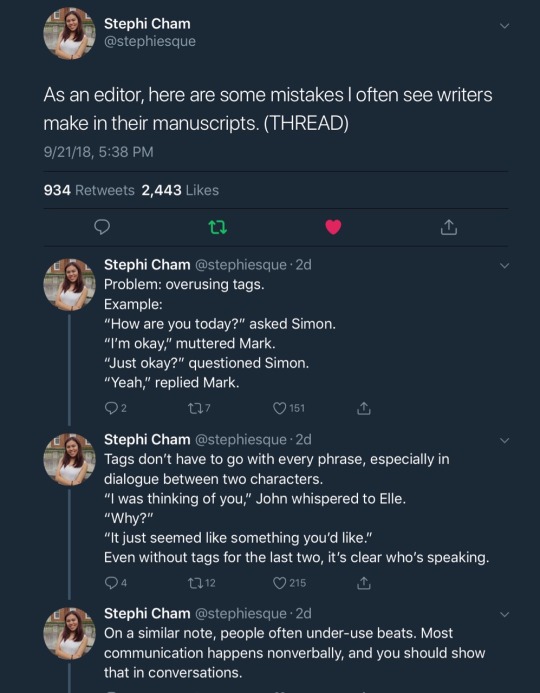Text
A Glossary of Commonly Confused/Misused Terms, Writer Edition
Alpha reader: Someone who reads along as you write a first draft of something to cheer you along and gas you up while you work. Sometimes they also provide suggestions of where to go or otherwise comment on what they’d like to see happen.
Beta reader: The writing equivalent of a beta tester. This is not someone who generally edits anything or tries to “fix” the story. They read and note how they feel and react to various things in the story so the writer can decide if it’s a “glitch” to fix. When I myself use these, I actually prefer they not be writers and in my target audience, because that’s the perspective I’m seeking for live reactions. Fanfiction betas tend to incorporate roles below this point because fanfiction is often a more casual environment with fewer people looking over the writing.
Proofreader: Prooooobably not what you think they do. A proofreader reads proofs. A proof is basically a “test” copy or a version of something. When you reformat a book from Scrivener or a Word document or Google Docs or whatever you wrote it in to something you can actually print as book-shaped or upload it as, sometimes weird things happen. A proofreader will compare these versions/formats to ensure that new formatting/file type/etc. didn’t mess up anything that actually matters. If you’re hired as a proofreader, you don’t usually edit anything (unless your employer is wildly misusing the term). These are not people who fix grammar or punctuation. They check for changes and to make sure everything came out the way it should have.
Copyeditor: What you probably think a proofreader does. Someone who edits copy. What is copy? Text, basically. Copyeditors edit grammar and punctuation and align the writing to whatever style guide is being used for some text and ensure the copy is clear and understandable. If they’re editing your voice regularly, they’re probably overstepping, but they will often suggest rearranging sentences or punctuating them differently. Professionally, this is a promotion from proofreading.
Developmental editors: People who suggest edits to the actual story—not word choices or grammar, but feedback on plot points and structure and characters arcs and how the story is being told and how it can be fixed. They are editing the story’s development. They provide what is called an "edit letter" that outlines changes to various aspects of the story.
Acquiring editors: The people who agree to buy your book at publishing companies. They usually do a dev editor’s job as well, but often specifically with an eye to making it more saleable.
Critique partner: A fellow writer with whom you exchange your writing for editing. Exactly what this entails depends on the people involved and what each wants, but this is someone who gives feedback on the book before an editor sees it and suggests how to fix the story as written. They can be any combination of the above terms depending on the partnership (except acquiring editors; they don't do that). Typically this will stray into developmental editing on some level.
89 notes
·
View notes
Text
I feel like some people need to relearn Genre Expectations... "Man, this tragedy sucks!!! Why didn't they just do XYZ, then everything could have ended happily!!" well, then it wouldn't be a tragedy, would it. "Man, this lighthearted teen romcom is terrible, it's so sappy and unrealistic!!" Well, yeah. If it had been gritty and dark, it wouldn't have been a lighthearted romcom, would it. Is the writing actually bad or are you just trying to order a milkshake from a Home Depot
85K notes
·
View notes
Text
So before AI entries forced moderation to discontinue poetry challenges, Ovipets used to have the occasional poem challenge that would provide a prompt and we could write a poem to enter and win a little in-game prize. Here’s some screenshots of poems I submitted during that time:
This isn’t all of them, just all the ones I have screenshots of. Might dig out the others later and reblog with a continuation. I do miss the poem and short story challenges though, I hope one day they can come back but as part of their volunteers who help sort entries, I completely understand the decision to stop hosting them.
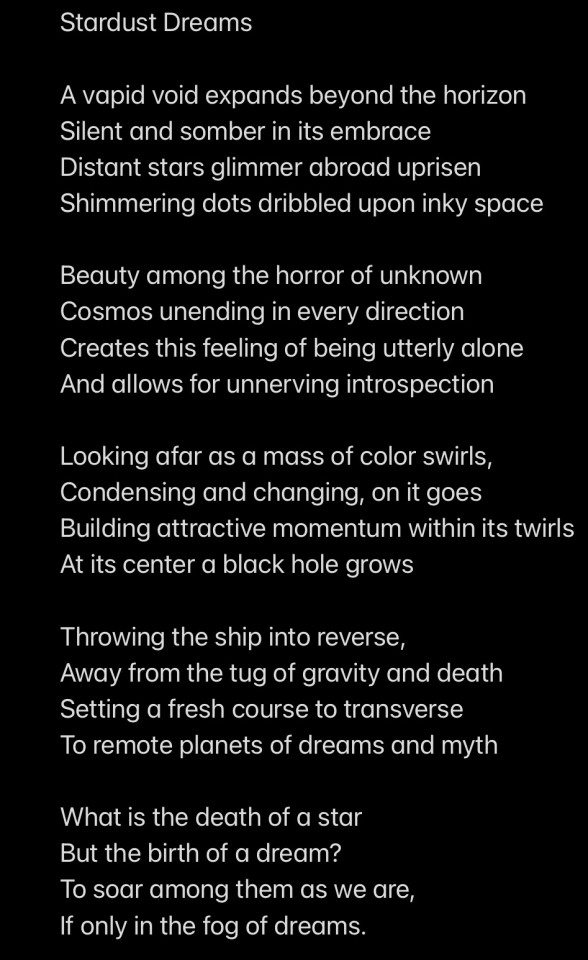

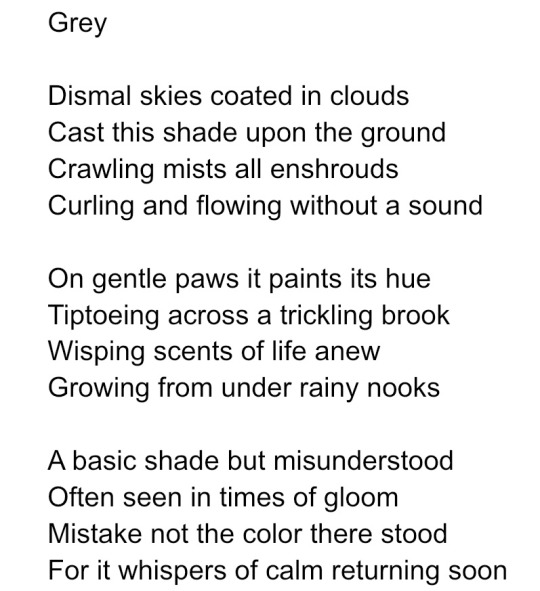


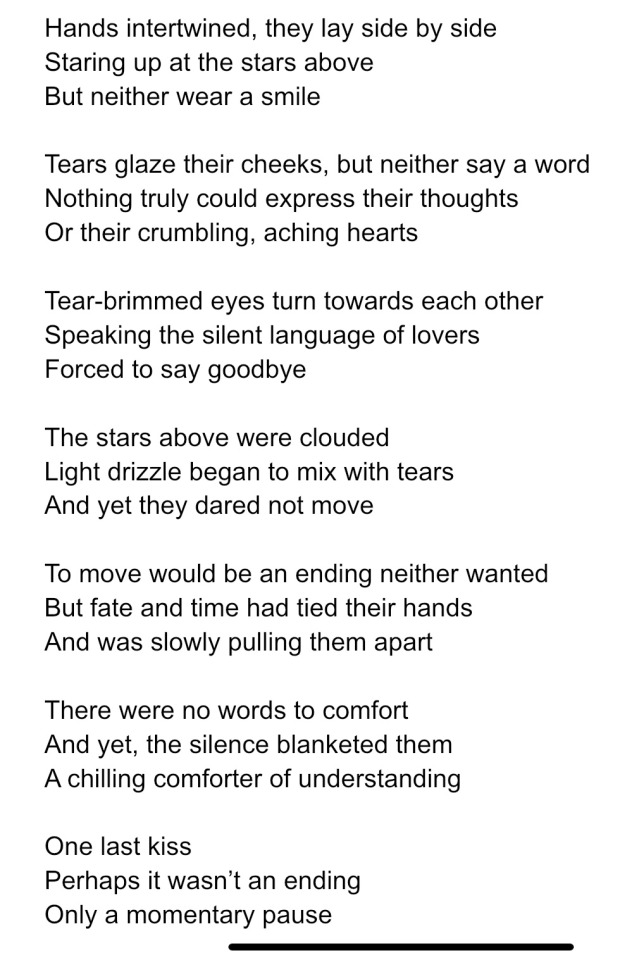


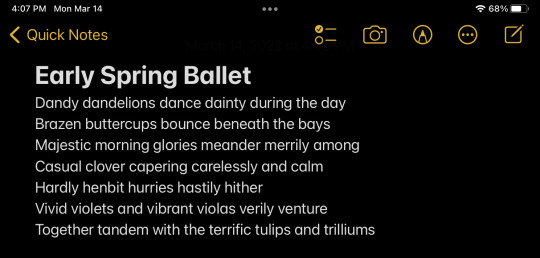
17 notes
·
View notes
Text
Disability Writing Guides
Collecting all of these in one convenient place! If you have any requests, questions, comments, and especially concerns about what/how I’m writing these, please let me know!
Writing Chronic Pain
Writing Deaf Characters
Writing Disability and the Idea of Cure
Writing Wheelchair Users
General Disability Etiquette for Writers
Overused Disability Tropes
Writing Blind/Low Vision Characters
Writing Facial Difference
Writing Seizures
Writing Visible vs. Invisible Disabilities
Writing Disability and Eugenics
Asks!
2K notes
·
View notes
Text
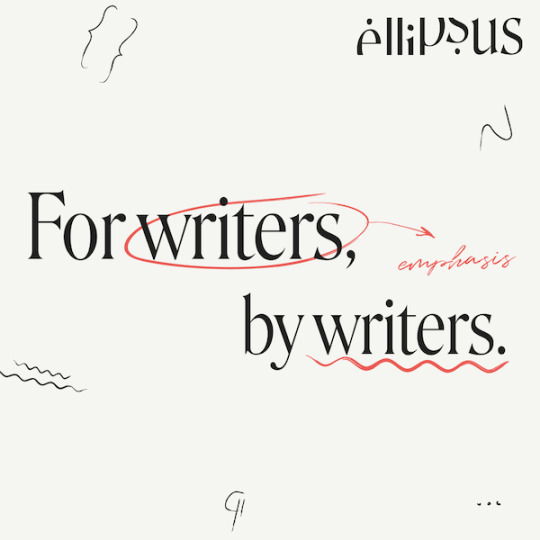
Collaborative writing is a labor of love. What if it could be easier?
Think connected drafts, not disconnected files.
Think effortless version history and control.
Think in-document chat.
Far away from the prying eyes of AI and LLMs.
Ellipsus is a new writing tool for people who write together!
Two new features have arrived this week: Comments and Dark Mode! :D
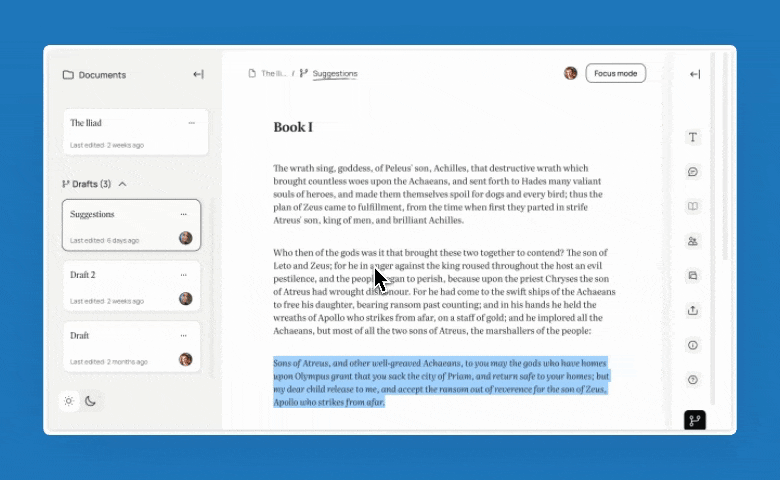
We’re looking for feedback from folks who care a lot about writing.
Check us out, and join the Ellipsus beta.
17K notes
·
View notes
Text
You Don't Need an Agent! Publishers That Accept Unsolicited Submissions
I see a few people sayin that you definitely need an agent to get published traditionally. Guess what? That's not remotely true. While an agent can be a very useful tool in finding and negotiating with publishers, going without is not as large of a hurdle as people might make it out to be!
Below is a list of some of the traditional publishers that offer reading periods for agent-less manuscripts. There might be more! Try looking for yourself - I promise it's not that scary!
Albert Whitman & Company: for picture books, middle-grade, and young adult fiction
Hydra (Part of Random House): for mainly LitRPG
Kensington Publishing: for a range of fiction and nonfiction
NCM Publishing: for all genres of fiction (YA included) and nonfiction
Pants of Fire Press: for middle-grade, YA, and adult fiction
Tin House Books: very limited submission period, but a good avenue for fiction, literary fiction, and poetry written by underrepresented communities
Quirk Fiction: offers odd-genre rep for represented and unagented authors. Unsolicited submissions inbox is closed at the moment but this is the page that'll update when it's open, and they produced some pretty big books so I'd keep an eye on this
Persea Books: for lit fiction, creative nonfiction, YA novels, and books focusing on contemporary issues
Baen: considered one of the best known publishers of sci-fi and fantasy. They don't need a history of publication.
Chicago Review Press: only accepting nonfiction at the moment, but maybe someone here writes nonfiction
Acre: for poetry, fiction and nonfiction. Special interest in underrepresented authors. Submission period just passed but for next year!
Coffeehouse Press: for lit fiction, nonfiction, poetry and translation. Reading period closed at time of posting, but keep an eye out
Ig: for queries on literary fiction and political/cultural nonfiction
Schaffner Press: for lit fiction, historical/crime fiction, or short fiction collections (cool)
Feminist Press: for international lit, hybrid memoirs, sci-fi and fantasy fiction especially from BIPOC, queer and trans voices
Evernight Publishing: for erotica. Royalties seem good and their response time is solid
Felony & Mayhem: for literary mystery fiction. Not currently looking for new work, but check back later
This is all what I could find in an hour. And it's not even everything, because I sifted out the expired links, the repeat genres (there are a lot of options for YA and children's authors), and I didn't even include a majority of smaller indie pubs where you can really do that weird shit.
A lot of them want you to query, but that's easy stuff once you figure it out. Lots of guides, and some even say how they want you to do it for them.
Not submitting to a Big 5 Trad Pub House does not make you any less of a writer. If you choose to work with any publishing house it can take a fair bit of weight off your shoulders in terms of design and distribution. You don't have to do it - I'm not - but if that's the way you want to go it's very, very, very possible.
Have a weirder manuscript that you don't think fits? Here's a list of 50 Indie Publishers looking for more experimental works to showcase and sell!
If Random House won't take your work - guess what? Maybe you're too cool for Random House.
123 notes
·
View notes
Text
Vasco approves of this message 😂
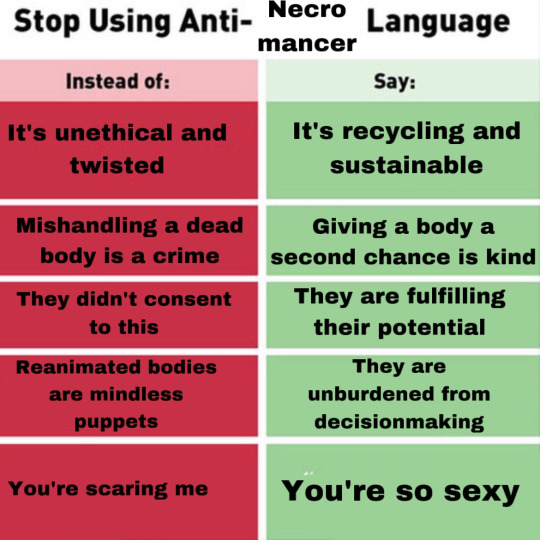
17K notes
·
View notes
Text
Hey, writers, you know that voice that pushes you to write more even when you're burnt out and just need to take a step back and take a break?
You know that voice that says "wow, that's all you did today?"
Do me a favor. Block that voice out for a second and listen to mine.
You did enough. What you've gotten done is absolutely enough. You are enough. Your work is enough. You're doing great. Take that break, take a rest. You're all good.
Love you guys. Take care of your minds so it can sustain your creativity the rest of your life and doesn't burn out <3
175 notes
·
View notes
Text
Fuck your word count!
༺𖤐๋࣭ ⭑🕸🦇🕸๋࣭ ⭑๋࣭ 𖤐༻
"Focus on your word count," "Write 2,500 words a day," "Real writers set monthly word goals."
SHUT UP! Your word count doesn't matter. You're just stressing yourself out.
It doesn't matter if you write one word today or 10,000! At least you wrote something! Focus on that.
Quality and sanity of quantity.
#I only really consider word counts when deciding chapter lengths if I vibe it or if it seems short/long#I have a nice range I like keeping chapters in because as a reader my focus will drift when it comes to super long chapters#i rather have a lot of short/medium chapters with a few long than mostly long with probably fewer chapters#but for writing motivation nah I don’t get motivated by word count or time just by getting myself to sit and focus that’s my struggle
354 notes
·
View notes
Text
Found some more of my poems written for the past ovi challenges! The last one is a two-image one as it was kinda long






So before AI entries forced moderation to discontinue poetry challenges, Ovipets used to have the occasional poem challenge that would provide a prompt and we could write a poem to enter and win a little in-game prize. Here’s some screenshots of poems I submitted during that time:
This isn’t all of them, just all the ones I have screenshots of. Might dig out the others later and reblog with a continuation. I do miss the poem and short story challenges though, I hope one day they can come back but as part of their volunteers who help sort entries, I completely understand the decision to stop hosting them.









17 notes
·
View notes
Text
The Writer's Guide to Authentic Wounds and Fatalities
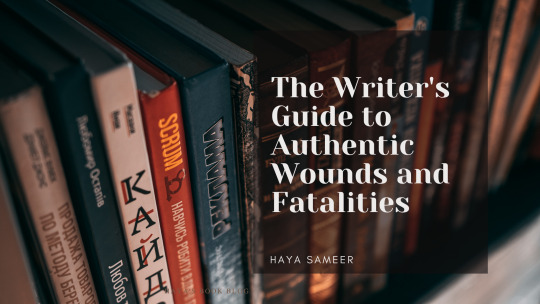
Writing fatal injuries in a story requires a delicate balance between realism and narrative impact. The portrayal of these life-altering events can evoke strong emotions in readers and shape the trajectory of your characters' journeys. In this blog, I will explore the intricacies of depicting fatal injuries in a manner that feels authentic, engaging, and respectful to the gravity of such circumstances. By understanding the nuances of fatal injuries, you will be equipped to craft compelling narratives that resonate with your readers.
Writing Fatal Injuries
When it comes to writing fatal injuries, it is crucial to approach the subject with care and accuracy. Fatal injuries carry immense consequences for your characters and can shape the trajectory of your story. By delving into the intricacies of portraying fatal injuries authentically, you can ensure that the gravity and impact of such events are effectively conveyed to your readers.
Choosing the right injuries for your story
Selecting the appropriate fatal injuries for your narrative involves considering various factors. Ask yourself: What purpose does this injury serve within the story? How does it affect the characters and the overall plot? Conduct thorough research to identify injuries that align with your story's context and resonate with the emotional journey of your characters.
For example, in a historical drama, you may research common fatal injuries during a particular era, such as battlefield injuries, diseases, or accidents prevalent at the time. In a crime thriller, you might explore the portrayal of fatal gunshot wounds or traumatic injuries resulting from violent encounters. By aligning the injuries with the context and themes of your story, you create a more immersive and believable experience for your readers.
Researching the mechanics of fatal injuries
To portray fatal injuries convincingly, it is essential to delve into the mechanics behind them. Understand the specific anatomical structures and systems involved, as well as the forces or mechanisms that can lead to fatal outcomes. Explore medical resources, consult experts if possible, and gather insights into the physiological and psychological implications of such injuries.
For instance, if your character suffers a fatal stab wound, research the anatomy involved, the potential organs affected, and the potential consequences such as internal bleeding or organ failure. By understanding the specific details and implications of the injury, you can describe the physical and emotional toll it takes on the character with greater accuracy and depth.
Depicting the immediate aftermath
When writing about fatal injuries, vividly describe the immediate aftermath to capture the intense emotions and physical realities. Consider the sensory details, the shock and disbelief experienced by characters, and the chaotic environment that often surrounds such events. Balancing realism with the needs of your story, create a scene that immerses readers and evokes empathy.
For example, if a character experiences a fatal car accident, you can depict the chaos at the scene, the character's disorientation, and the reactions of witnesses. Emphasize the sensory details such as the sound of screeching tires or the smell of burning rubber, creating a visceral experience for your readers.
Emotional and dramatic impact on the narrative
The impact of fatal injuries extends beyond the immediate moment. Explore the ripple effects on other characters, relationships, and the overall plot. Delve into the emotional responses, grief, guilt, anger, or determination that arises in the aftermath of loss. Utilize these emotional arcs to deepen character development and drive the narrative forward.
For instance, the loss of a loved one due to a fatal illness might lead to grief and strained relationships among the remaining family members. The emotional journey of a character grappling with guilt and seeking redemption after causing a fatal accident can become a central theme in your story. By delving into these emotional arcs and their consequences, you add depth and resonance to your narrative.
Writing Minor Injuries
While fatal injuries may capture our attention with their dramatic impact, it is equally important to pay attention to the portrayal of minor injuries in your writing. Minor injuries, though less severe, can still significantly affect your characters and contribute to the authenticity of your story. In this section, we will explore the art of depicting minor injuries, ensuring that they are not overlooked or trivialized. By delving into the nuances of minor injuries, you can add depth and realism to your characters' experiences.
Types of minor injuries to consider
When crafting your story, it is essential to consider a range of minor injuries that can occur. These injuries can include cuts, bruises, sprains, minor burns, or even minor fractures. Each type of injury carries its own unique characteristics, associated pain levels, and recovery processes. By understanding these distinctions, you can create accurate and believable depictions that resonate with your readers.
For example, a character who sustains a cut on their hand may experience sharp pain, the sight of blood, and the need for immediate first aid. On the other hand, a character with a sprained ankle may struggle with mobility, experience swelling, and require rest and care for a few days. By paying attention to these specific details, you can enhance the realism of your storytelling.
Conveying pain and discomfort
When writing about minor injuries, it is important to effectively convey the pain and discomfort experienced by your characters. Consider describing the sensation of pain, the throbbing or stinging feeling, and how it affects their daily activities or interactions. Showcasing the emotional impact of pain, such as frustration, irritation, or vulnerability, can deepen the readers' connection to the character's experience.
For instance, if a character suffers from a sprained wrist, you can describe the dull ache that persists, making simple tasks like typing or holding objects challenging. By capturing these small but significant moments, you immerse readers in the character's struggle and create a more realistic portrayal.
Balancing realism with narrative pace
While it is important to depict minor injuries realistically, it is also crucial to strike a balance with the overall pace and momentum of your story. Consider the significance of the injury within the larger context of your narrative. Some injuries may require more detailed attention and impact the plot, while others may serve as background elements. Adjust the level of detail and focus accordingly, ensuring that the portrayal of minor injuries aligns with the narrative's flow.
For example, a small cut on a character's finger may not require an extensive description unless it becomes infected or triggers an unexpected consequence. By aligning the portrayal of minor injuries with their narrative relevance, you maintain a consistent pace while still acknowledging their impact on your characters' lives.
Writing Bloodshed And Realistic Blood Loss
When writing about wounds and injuries, it is essential to consider the amount of blood loss your characters may experience. Realistic portrayal of bloodshed can enhance the authenticity of your scenes and immerse readers in the gravity of the situation. In this section, we will explore the factors influencing blood loss and techniques for accurately depicting it in your writing.
Understanding blood loss and its impact on the body
To authentically portray blood loss, it's crucial to have a basic understanding of how the human body responds to injury. Research the circulatory system and the role of blood in transporting oxygen and nutrients throughout the body. Consider the different types of blood vessels and their potential for bleeding when injured. This knowledge will help you create realistic scenarios and determine the appropriate level of blood loss for specific injuries.
Factors influencing blood loss in different injury scenarios
The amount of blood loss can vary depending on the severity and location of the injury. Factors such as the size of blood vessels, the rate of bleeding, and the body's ability to clot play a significant role. For example, a deep laceration in an artery will result in more substantial blood loss compared to a superficial cut on the skin. Consider these factors when describing injuries and their resulting bloodshed.
Techniques for accurately portraying blood loss in writing
There are several techniques you can use to convey the realistic impact of blood loss in your writing. Describing the color, consistency, and flow of blood can provide vivid imagery. You can also include physical symptoms such as dizziness, weakness, or fainting that may accompany significant blood loss. Additionally, consider the emotional response of your characters and how they react to the sight of blood or their own injuries.
By incorporating these techniques, you can create scenes that evoke a visceral response in readers and enhance the authenticity of your writing.
Bruises: Colors, Progression, and Pain
Bruises are a common result of injuries, and understanding how they form, change in color, and cause discomfort can greatly enhance the realism of your writing. By accurately describing bruises, you can bring depth to your characters' injuries and portray their healing process convincingly.
Understanding the stages and colors of bruises
Bruises go through distinct stages of color as they heal. Initially, they may appear red or purple due to the broken blood vessels beneath the skin. Over time, the color changes to blue, green, yellow, and eventually fades to a brown or yellowish hue. Understanding this color progression can help you accurately describe the age of a bruise and the healing process.
For example, a fresh bruise might be vivid purple, indicating recent trauma, while a fading bruise may have a yellowish tinge, suggesting that healing has begun. By incorporating these color details, you can add realism to your characters' injuries and track the passage of time within your narrative.
Depicting the progression of bruises over time
As bruises heal, they often change in appearance and size. Initially, a bruise may be small and localized, but it can gradually spread and become more extensive. Describing this progression can provide a sense of the healing process and the passage of time within your story.
For instance, a character who sustains a significant blow to the face may develop a bruise that starts as a small spot near the eye but expands to cover a larger area over the next few days. By accurately portraying the progression of bruises, you enhance the authenticity of your characters' injuries and their recovery.
Conveying the pain and sensitivity associated with bruises
Bruises can be painful, sensitive to touch, and affect a character's movement and daily activities. Describing the pain and discomfort experienced by your characters can create empathy and immerse readers in their physical ordeals.
Consider conveying the tenderness of a bruise when pressure is applied, the throbbing sensation, or the limitation of movement due to the pain.
Remember The Side Effects
Injuries, whether minor or severe, often come with a range of side effects that can significantly impact your characters' lives. These side effects can extend beyond the physical realm and encompass emotional, psychological, and social aspects.
Physical side effects
Injuries can have profound physical side effects that go beyond the immediate pain and discomfort. Consider the potential consequences such as limited mobility, impaired coordination, chronic pain, or the need for assistive devices like crutches or braces. Describing these physical side effects can add depth to your characters' struggles and provide a realistic portrayal of their healing journey.
For example, a character who sustains a leg injury may experience difficulty walking, require physical therapy, or have long-term complications that affect their day-to-day activities. By addressing these physical side effects, you create a more nuanced depiction of the aftermath of injuries.
Emotional and psychological side effects
Injuries can have a profound emotional and psychological impact on characters. They may experience fear, anxiety, trauma, or a loss of confidence. Consider how the injury affects their self-image, relationships, or mental well-being. Explore the emotional journey your characters undergo as they navigate the aftermath of their injuries.
For instance, a character who survives a near-fatal accident may develop post-traumatic stress disorder (PTSD) and struggle with recurring nightmares or panic attacks. By incorporating these emotional and psychological side effects, you can deepen the complexity of your characters and their responses to traumatic experiences.
Social implications and changes
Injuries can also lead to significant social changes for your characters. They may face challenges in their personal relationships, encounter stigma or discrimination, or experience changes in their roles or identities. Explore how the injury affects their interactions with others and their sense of belonging in the world.
For example, a character who sustains a facial injury may encounter judgment or stares from others, leading to self-consciousness or isolation. By addressing the social implications and changes resulting from injuries, you can create multi-dimensional characters and explore the impact of their injuries on their social dynamics.
By incorporating these various side effects into your writing, you bring depth and authenticity to your characters' experiences and showcase the wide-ranging impact of injuries.
Conclusion
Writing authentic wounds and fatalities requires attention to detail and a deep understanding of the physical, emotional, and psychological aspects involved. By following the guidelines and exploring the subheadings discussed in this guide, you can create compelling and realistic portrayals of injuries in your writing.
Remember to conduct thorough research on the specific injuries you want to depict, understanding their mechanics, symptoms, and potential outcomes. Consider the immediate and long-term effects on your characters, both physically and emotionally. Incorporate sensory details to immerse readers in the experience, describing the pain, bloodshed, colors of bruises, and the progression of healing.
Additionally, don't forget to address the side effects that injuries can have on your characters' lives. Explore the physical limitations, emotional struggles, and social implications that arise from their injuries. By delving into these aspects, you can create well-rounded characters and compelling narratives that resonate with readers.
I hope this blog on forging epic battles will help you in your writing journey. Be sure to comment any tips of your own to help your fellow authors prosper, and follow my blog for new blog updates every Monday and Thursday.
Looking For More Writing Tips And Tricks?
Are you an author looking for writing tips and tricks to better your manuscript? Or do you want to learn about how to get a literary agent, get published and properly market your book? Consider checking out the rest of Haya’s book blog where I post writing and publishing tips for authors every Monday and Thursday! And don’t forget to head over to my TikTok and Instagram profiles @hayatheauthor to learn more about my WIP and writing journey!
4K notes
·
View notes
Text
Sebastian: I'll handle her when she's a werewolf, if she accidentally bites someone it should be me
Cody: What, no. I'd be an awesome werewolf, I'd be like a werehusky. Loveable, loud, playful, just give me food, scratch my head, I'm good.
Sebastian: I'm her dad though so it should be me
Cody: You're the responsible one. Plus, you'd be one cunning werewolf. I'm not sure I could outsmart you, you'd probably use tools and traps and stuff
Sebastian: *sigh* How about we both just try not to get bitten?
Cody: Fiiiiiine but I stand by that I'd be a good one
Sebastian: What about your job?
Cody: Easy. I tell them I got a big guard dog I'm now bringing for the security walks too some nights,
Sebastian:
Sebastian: That's actually pretty good
Cody: I know~
#help! my baby's a werewolf#h!mbaw#hmbaw#Two brothers vs one toddler werewolf#they’re doing their best
5 notes
·
View notes
Text
I have a nice, sizable stack of wips to chip at right?
And then out of nowhere I get hit with a new idea nothing like the others I’m working on.
….Thankfully it’s vague enough I could just jot down the basic premise and sit it aside for now.
As it is, trying to make progress on Hidden Earth while my other WIPs are trying to also give ideas is challenge enough.
Sometimes it’s like they get jealous that they’re not the ones I’m focusing on.
4 notes
·
View notes
Text
Writeblr (re)intro
I’m not new here, but I’m trying to be more active after disappearing for a while and it looks like I might finally be building some community so let’s do this!
Sadly, this is a side-blog so I follow and interact from @winglesss
I’m Kate (they/them) and I’m a queer sci-fi/fantasy romance writer.
My goal is to write books I want to read — the kind of books I missed when I was younger, where queer people go on adventures, fall in love, and eventually get their happy ending. I’m a big fan of escapism, so there is always some fantastical element to my books, but it’s hard to tell whether my next story will take place in space or in the fairy realm. Thanks to my rich background in fanfiction, you can expect my books to be fast-paced, character-driven, and full of lovely tropes.
I self-published my debut novel BUILT ON RUINS
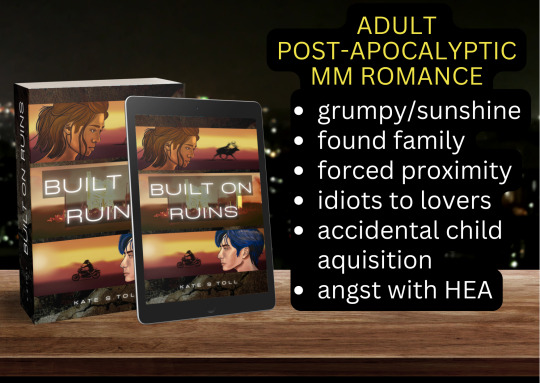
It’s available on Amazon and Kindle Unlimited.
My current WIPs:
Foreigner God
Synopsis: two hostile nations, two reincarnated gods, two men who want to do good by their people, and a dark force that doesn’t care whose life it takes. The only way to defeat it is to join efforts, to reveal the past and tap into lost powers even if it means falling in love with the enemy.
Status: Finishing 1st draft
Ghost/Monk/Witch
Synopsis: Victorian paranormal romance between a witch-hunting monk, an eccentric witch, and the dead owner of the countryside manor where it all takes place (M/M/M)
Status: Draft 1 on hold
You want it darker
Synopsis: Distopic fantasy, enemies to lovers, the bed guy gets the guy
Status: Plotting
What I post
Tag games, writing memes, writing resources, some whiny posts about my own writing
23 notes
·
View notes
Text
Reblog if it's okay to invade your ask box.
Always
372K notes
·
View notes
Text
Filler??? In MY story?!
You'd better believe it. :)
Filling can have its own way of progressing the story -if not the plot, then the understanding of the characters when they're not buried in a plot-alanche.
Moments of rest are necessary for both the characters and the reader.
Moments of softness are necessary for both the characters and the reader.
Moments of 'slice of life' are necessary for both the characters and the reader.
It comes down to one simple to say, yet complicated piece of advice that I keep as a golden rule:
Bring it inward to make it bigger.
425 notes
·
View notes
